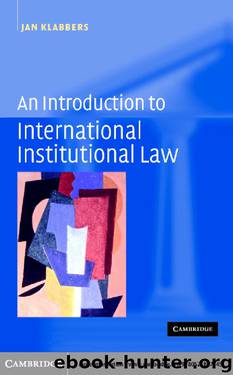An introduction to international institutional law by Jan Klabbers

Author:Jan Klabbers [Klabbers, Jan]
Language: eng
Format: epub
Tags: General, International Relations, Air & Space, Political Science, International agencies, International, Law
ISBN: 9780521520935
Publisher: New York : Cambridge University Press, c2002.
Published: 2002-12-01T08:55:57.273000+00:00
188 an introduction to international institutional law
The situation with respect to the remaining principal organs of the United Nations is relatively clear. Under Article 87 of the Charter, the Trusteeship Council is clearly subordinate to the General Assembly; somewhat less explicitly, something similar follows from Article 66 with respect to ECOSOC.
The Secretary-General,75 in turn, has very few powers of his own, and such powers as he does have are fairly general. They are not described as ‘exclusive’
or something similar, thus the question of hierarchy hardly presents itself; rather, his powers in many areas are complementary. While the Secretary-General has the power to bring matters to the attention of the Security Council (Article 99), this is clearly discretionary, and moreover does not get in the way of the powers of other organs.76
Things are different, though, with the remaining three principal organs.
The 1962 Certain Expenses case77 was the result of the inactivity of the Security Council in the 1950s when it came to peace-keeping. In 1950, the Council had allowed the UN to do something about the conflict in Korea, due to the absence of the USSR at the crucial moment.
The General Assembly, understanding that such a fortunate situation was not likely to happen again, adopted its famous Uniting for Peace resolution,78 granting itself the power to send missions to the world’s hot-spots. And indeed, in the 1950s, peace-keeping missions went to the Middle East (UNEF), and, in the early 1960s to the Congo (ONUC), more or less under authority of the General Assembly.79
As such, that presented few problems. Obviously, the General Assembly cannot take binding decisions, and thus cannot force member-states to send troops. Moreover, it cannot act under Chapter VII of the Charter, so both UNEF and ONUC were established with the consent of the parties involved.
75 Incidentally, the Secretary-General is not an organ of the UN; the Secretariat is.
76 Which is not to deny that any conflicts ever take place between the Secretary-General and other organs. For an insightful discussion of the power struggles between Secretary-General Hammarskjöld and the Security Council, often revolving around the interpretation of the latter’s resolutions, see generally Georges Abi-Saab, The United Nations Operation in the Congo 1960–1964 (Oxford, 1978). On the relationship between the Secretary-General and the ICJ, see Carl-August Fleischhauer, ‘The Constitutional Relationship between the Secretary-General of the United Nations and the International Court of Justice’, in Georges Abi-Saab et al. , Paix, développement, démocratie: Boutros Boutros-Ghali Amicorum Discipulorumque (Brussels, 1999), 451–74.
77 Certain expenses of the United Nations (Article 17, paragraph 2, of the Charter), advisory opinion,
[1962] ICJ Reports 151.
78 Resolution 377 A(V), of 3 November 1950.
79 With respect to ONUC, the General Assembly only intervened for a short period of time. See generally Abi-Saab, The United Nations Operation.
Download
This site does not store any files on its server. We only index and link to content provided by other sites. Please contact the content providers to delete copyright contents if any and email us, we'll remove relevant links or contents immediately.
The Pirates of Somalia by Jay Bahadur(1573)
Political Theology by Carl Schmitt(1531)
The Holocaust: A New History by Laurence Rees(1470)
The Social Animal by David Brooks(1394)
A Practical Guide to International Arbitration in London by Hilary Heilbron(1378)
Restitution by Restitution(1373)
Pirates of Somalia by Jay Bahadur(1331)
Coercing Virtue by Robert H. Bork(1308)
The Nuremberg Interviews by Leon Goldensohn(1254)
Basic International Corporate Taxation by Sebastiano Garufi(1161)
A History Of Thailand by Baker Chris(1135)
The Global Commons by Susan J. Buck(1093)
International Trade and Business: Law, Policy and Ethics by Gabriël Moens & Peter Gillies(1092)
Asian Waters by Humphrey Hawksley(1084)
Blood Profits by Vanessa Neumann(1071)
Spring Fever: The Illusion of Islamic Democracy by McCarthy Andrew C(1062)
The Sovereignty of Human Rights by Macklem Patrick(1056)
The Nuremberg Trials: The Nazis and their Crimes Against Humanity by Roland Paul(1010)
Crimes Against Humanity: Historical Evolution and Contemporary Application by M. Cherif Bassiouni(984)
